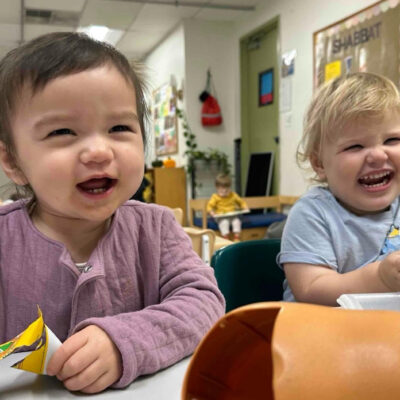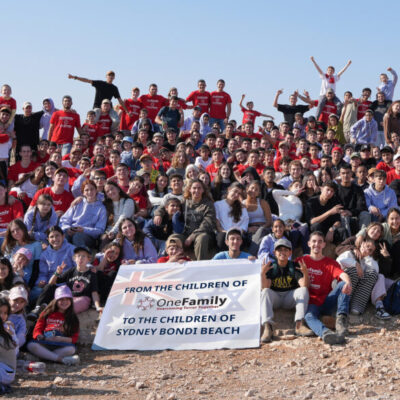Opinion
PEOPLE OF THE BOOKS
Rolling the Torah scroll from Simchat Torah to Bereishit
I have always been an avid reader, inhaling books as quickly as I could get my hands on them and making weekly Friday visits to my local public library so I could replenish my stack of books for the coming Shabbat. College and graduate school offered new libraries to explore, new favorite study spaces and stacks upon stacks of books buried deep underground where I could sit and browse until the automated lights switched off and left me in the dark.
As I toured the new National Library of Israel in late November, I found myself evaluating the nooks and crannies of its beautiful reading rooms and imagining my ideal space. As CEO of The Russell Berrie Foundation, I was privileged to tour the space twice during its construction; the second time when the Library agreed to dedicate The Russell Berrie Entrance Hall as part of a Trustee visit, despite it turning out to be nearly a year before the entire building was completed. Neither visit prepared me, however, for what it would feel like to experience the library, filled with patrons, less than two months after Oct. 7.

A photo taken on Nov. 21, 2023 at the new building of the National Library of Israel in Jerusalem shows an installation consisting of chairs with books and portraits of Israeli hostages taken by Hamas during the Oct. 7 attack. Photo by Kenzo Triboulliard/AFP via Getty Images
With its spiraling floors, inspiring artwork and soaring staircases, light streaming from its cut-out windows, the library is an architectural masterpiece. But it was the people who brought it to life. Heads — bare or covered with black hats, hijabs, kippot or wraps — bent over books and manuscripts. Friends catching up over coffee. Eleven year olds participating in a writing workshop. Visitors circumnavigating the empty chairs set up to honor the hostages, each seat bearing a carefully chosen book. My youngest nephew, who had to be bribed to leave his perch watching the robotic arms retrieve material from among the 4.1 million books stored in a state of the art, oxygen-depleted section designed for maximum preservation.
It is also the people who remain seared in my heart from the two weeks I spent in Israel, a trip that was part comforting the mourners and visiting the sick, part affirming that life endures, part understanding the responsibilities of philanthropy and mostly bearing sacred witness to the trauma and the resilience that persists three months after Oct. 7..
My mind goes to the resident of Kfar Aza showing us the kibbutz’s devastated youth quarters, pointing to each house in the row and reciting “kidnapped, killed, killed, kidnapped” — an especially poignant memory after two of the kidnapped were among those mistakenly and tragically killed by the IDF on Dec. 15.
The continuing nightmare of Jon Polin and Rachel Goldberg, parents of Hersh Goldberg-Polin, who have braved every one of the 100-plus days since he was taken hostage with determination and strength.
The fresh-faced young men to whom my volunteer group had the privilege of serving dinner at their army base, mere hours before they entered Gaza, a reminder that nobody who has visited with a battalion of Israeli combat soldiers could credibly argue that all Jews are white.
My beloved colleagues, who continue to assess needs and facilitate partnerships even as they cope with the fear and anxiety of family members on the front lines; and numerous grantee leaders who have become treasured friends, doing the impossible in managing their teams through the uncertainty of a trauma-inflected present while responding to the enormous call to prepare for the day after.
And yet, throughout my trip, I kept returning to how I felt at the National Library of Israel. Even the NLI’s leadership expressed some surprise to me at how many people now walk through its doors on a daily basis; but to me, the explanation seemed obvious. In Covenant and Conversation: Deuteronomy, Rabbi Lord Jonathan Sacks explains:
“The Torah ends with the last command: to keep writing and studying Torah. And this is epitomized in the beautiful custom, on Simchat Torah, to move immediately from reading the end of the Torah to reading the beginning. The last word in the Torah is Yisrael; the last letter is a lamed. The first word of the Torah is Bereishit; the first letter is beit. Lamed followed by beit spells lev, ‘heart.’ So long as the Jewish people never stop learning, the Jewish heart will never stop beating. Never has a people loved a book more. Never has a book sustained a people longer or lifted it higher.”
Israel is stuck at Simchat Torah. We’ve seen the memes that belie a deeper truth about the emotional and mental state of the Israeli public: “How can it be Chanukah, when it’s still Simchat Torah?” “It can’t be Jan. 1 when it’s still Oct. 787.” On my visit, I was confronted with two potential visions for Israel’s future, one optimistic and one pessimistic, depending on circumstances. Uncertainty, the dominant mood in Israel, exists precisely on that border between optimism and pessimism, driven by the awareness that so much feels beyond our individual control.
Given this anxiety and uncertainty, Israelis and Jews around the world feel unable to wholly roll the Torah scroll to Bereishit, to the new beginning. As a vessel of the Jewish people’s devotion to lifelong learning, the National Library of Israel embodies Rabbi Sacks’ connection between the heart of the Jewish people and its stories. The National Library of Israel, with its architectural grandeur, its blend of 21st-century technology and ancient texts and its inclusive vision of a home for all citizens, symbolizes what Israel can accomplish and what it can be when it is at its very best. At a time when so many feel shattered and abandoned, when it feels nearly impossible to breathe, the National Library of Israel holds open the yet unrealized possibilities for moving from Simchat Torah to Bereishit.

 Add EJP on Google
Add EJP on Google










